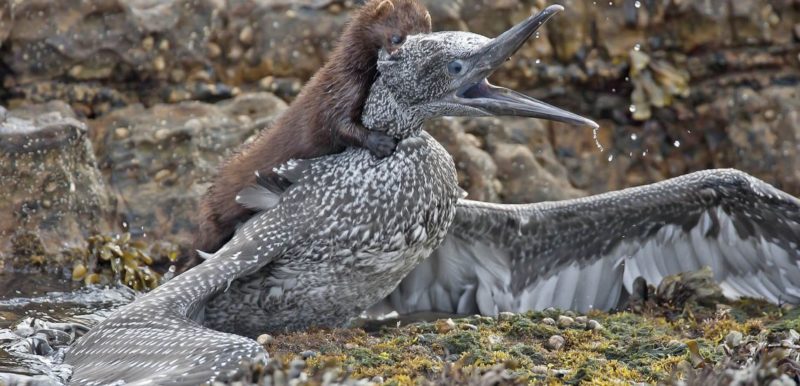Governments, non-governmental organisations and local communities have taken up the Honolulu Challenge and agreed to take bold actions to counter invasive alien species that harm biodiversity.
During the 2016 World Conservation Congress that held recently in Honolulu in Hawai’i, a call was made by the International Union for the Conservation of Nature (IUCN) and the host community in in the U.S. state for greater action in addressing invasive alien species in order to protect biodiversity and human wellbeing from their impacts.

Invasive alien species are species that have been moved by humans, either by accident or intentionally, into areas outside of their natural habitats, and pose negative impacts upon native biodiversity, ecosystem services or human well-being. They are also regarded as plants, animals, pathogens and other organisms that are non-native to an ecosystem, and which may cause economic or environmental harm or adversely affect human health.
“Invasive alien species are among the most serious threats to biodiversity, and have a potentially devastating impact on our food security, health and economies,” says Inger Andersen, IUCN Director General. “The launch of the Honolulu Challenge couldn’t be more timely: concrete action is urgently needed if we want to curb species loss and meet the Sustainable Development Goals.”
Governments, non-governmental organisations and communities are making progress by taking steps to put preventive measures in place, and to eradicate or control already established invasive alien species.
“We need more bold actions,” said Braulio Ferreira de Souza Dias, Executive Secretary of the Convention on Biological Diversity (CBD), at the launch of the Honolulu Challenge.
“Several global targets, including Aichi Biodiversity Targets 9 and 12, are far from being met. Invasive species still wreak havoc on numerous threatened species and ecosystems and have a serious economic impact in all countries. This is particularly relevant to oceanic islands, where urgent action is needed to prevent and eradicate invasive alien species which pose high risk on endemic and endangered species. More collaboration and fast actions are needed,” he added.
“New Zealand is lending its support to the Honolulu Challenge as a leader in combating invasive species and protecting biodiversity,” says Conservation Minister for New Zealand, Maggie Barry. “Our predator-free vision is by far the largest such project ever attempted and has drawn significant international interest. Through Predator Free 2050 the Government has set a target of completely eradicating possums, rats and stoats from New Zealand and making the country safe again for the native species these introduced predators threaten to wipe out. As a Government we’re backing New Zealanders to be at the forefront of a global solution.”
Invasive alien species are a major driver of species extinction and also threaten agricultural, forestry and aquaculture production. Their negative impact costs 20 billion Euros in the European Union each year, according to the Institute of European Environmental Policy, and $120 billion in the United States. The problem is said to be growing globally due to the influences of globalisation and climate change.
Between 1970 and 2007, the number of invasive alien species in Europe grew by 76 per cent.
The Honolulu Challenge proposes 11 measures to address this threat, including to:
- Multiply efforts to develop and enact effective biosecurity policies and programmes for countries and islands;
- Greatly increase the number and scale of invasive alien species eradications, especially on islands and in other priority sites;
- Integrate prevention and control of invasive alien species into planning and management for Protected Areas and Key Biodiversity Areas;
- Invest in the development, application and sharing of innovative technologies, and other solutions to prevent further invasions, and eradicate or control invasive alien species;
- Engage with relevant sectors and civil society to raise awareness of invasive alien species,
including the compounded impacts under climate change, and increase public support for potential solutions.
Four governments and expert organisations declared commitments to achieve their challenges at the launch in Honolulu. New Zealand has committed to making the country free from invasive alien predators by 2050, and to eradicate all invasive alien species from island nature reserves by 2025. The Australian Commonwealth Scientific and Industrial Research Organisation (CSIRO) has committed to doubling its long-term co-investment in invasive alien species management. BirdLife International aims to remove invasive alien threats from at least a further 35 oceanic islands worldwide by 2020. Island Conservation has committed to protect more than 100 threatened species at risk from invasive species on 40 oceanic islands by 2020.
In Mexico, the Grupo de Ecología y Conservación de Islas, A.C. (GECI) with the support of federal government and local communities, has committed to removing invasive mammals from all islands of Mexico by 2030.
The Secretariat of the Convention on Biological Diversity is a supporter of this initiative. At its UN Biodiversity Conference1, to be held in Cancun, Mexico, from 4 to 17 December 2016, the Conference of the Parties to the Convention on Biological Diversity will consider further measures to be taken under the Convention to achieve Aichi Biodiversity Target 9.
